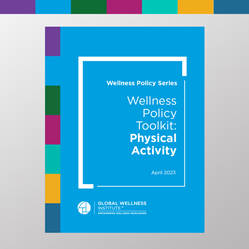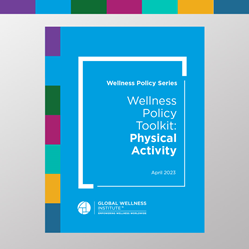
What makes the GWI toolkit unique is that it is accessible and relevant to anyone.
MIAMI (PRWEB)
April 14, 2023
The nonprofit Global Wellness Institute™ (GWI), the leading research and educational resource for the global wellness industry, today released the Wellness Policy Toolkit: Physical Activity. The toolkit takes a deep dive into what is driving rising levels of physical inactivity worldwide and the many tangible ways that new policies, government resources and public-private partnerships can tackle the crisis. It outlines six distinct areas of policy action: from encouraging physical activity via the built environment, to addressing racial and ethnic disparities, to integrating physical activity into the medical system. It was released today at FIBO in Cologne, Germany, the world’s leading international trade show for fitness, wellness and health.
Download the free report here.
The GWI’s new Wellness Policy Series will ultimately include nine reports. The first, “Defining Wellness Policy,” argues why “wellness policy” is now needed and explains that while it supports healthcare, public health and happiness/wellbeing policies, it is not the same thing. The second, “Health, Happiness and the Wellness Economy,” is the first empirical analysis to uncover a positive relationship between wellness spending and diverse happiness and health outcomes. Now the research organization turns to seven wellness policy toolkits that give governments and other stakeholders concrete action plans to address gaps in each wellness domain—whether it’s physical activity, wellness at work, or wellness in the built environment. The wellness policy series was born out of a profound reality: The commercial wellness market cannot bring wellness to all or solve our skyrocketing health crises. Public policy is crucial to fill the gaps. For instance, GWI research finds that the booming fitness industry serves just 3-4% of the world’s population.
The Cost of our Sedentary World: The toolkit lays out the global research on why policy action around physical activity is so direly needed. An estimated 27.5% of the world’s adult population is now physically inactive (based on World Health Organization standards). Physical inactivity is now the fourth leading cause of death and the pandemic only increased our sedentary behavior. The WHO estimates that physical inactivity will cause 500 million new cases of preventable diseases, and $300 billion in treatment costs, from 2020-2030, if things do not change.
“Many governments all over the world have formulated strategies and action plans to tackle the inactivity crisis, but far more widespread efforts are needed,” said Katherine Johnston, GWI senior research fellow. “What makes the GWI toolkit unique is that it is accessible and relevant to anyone. It presents an extremely broad range of possible actions and policy steps that can be pursued by people working in all levels of government, as well as nonprofits, community organizations and businesses. We hope it will spark a movement across all these sectors to identify ways—both large and small—to get more people moving.”
Six Areas of Policy Action for Physical Activity:
The toolkit identifies six areas of action that would drive far more physical activity participation and access. For each item, GWI researchers lay out the problem that needs solving and the many specific policy actions that can be deployed, all interspersed with examples of creative, successful policy moves already underway.
1) Encourage Physical Activity Via the Built Environment
The issue: Our modern built environment encourages sedentary behavior, from our automobile-centric culture that makes it difficult for people to walk or ride bikes to indoor spaces that actively discourage movement (i.e., prominent elevators and hidden stairs).
Actions: Design cities, neighborhoods and buildings that make movement a default in daily life and boost active transit—including complete streets, multi-use trails/greenways, car-free zones, public transit, bike-sharing, etc. Use urban/regional planning to encourage walking and cycling as transport, and incorporate active design into real estate developments.
Example: During the pandemic, cities worldwide took action to help people move around more easily, from closing streets to cars to make room for pedestrians/cyclists to providing free bike-sharing. Now cities like Paris, New York, Milan, Bogota, Lima, Brussels, Rome, and more are making these changes permanent.
2) Make Recreational Physical Activity Accessible, Convenient and Affordable
Issue: GWI research finds that only about one-third of the world’s population participates in recreational/leisure physical activities or exercise on a regular basis—the issue is mainly lack of time, but also convenient access and money.
Actions: Invest in recreational physical activity infrastructure, facilities and programs; treat recreational physical activity as an essential public service, not a nice-to-have amenity; establish a “sports for all” policy framework or action plan; create more free and accessible public spaces for outdoor recreation; sponsor free exercise classes, programs and educational campaigns; invest in subsidized and public-private fitness facilities.
Example: The UK, Ireland and Australia embrace a public-private model: Gyms and leisure centers are subsidized by governments but often run by private contractors. Australia’s “Live Life Get Active” program offers free daily outdoor fitness classes in over 100 communities through this model.
3) Improve Access to Physical Activity for Underserved Populations
Issue: Women, minorities, disadvantaged communities, and people living with disability and chronic disease are more likely to be inactive across all countries. The private fitness industry often leaves out marginalized populations who are at highest risk for physical inactivity and chronic disease.
Actions: Target physical activity infrastructure investments to increase access and reduce cost barriers for high-risk populations and underserved communities. Develop safe and comfortable spaces for women and girls to exercise; support fitness options for older adults; make physical activity accessible to people living with disabilities; address racial and ethnic disparities in physical activity.
Example: The Race Equality First (REF) program in Wales creates equal opportunities in sport and physical activity for Black and minority ethnic communities (especially Muslim women and girls) with free events across the country, such as women-only yoga, fitness, walking groups and swimming sessions.
4) Integrate Physical Activity into the Health System
Issue: The healthcare system is woefully disconnected from the physical activity sector. Promoting exercise as a part of routine patient care is critical for the least active people and those with chronic diseases and disabilities that may make them uncomfortable in a traditional gym/studio.
Actions: Incorporate physical activity into prevention and treatment protocols, working in cooperation with the health system; implement exercise as medicine and exercise prescription initiatives; develop medical fitness centers (in the US, there are over 1,400) and co-locate physical activity and healthcare facilities.
Example: The UK is the leader in prescribing exercise: Doctors refer patients to free fitness/leisure centers, and in 2022, the NHS began a program that prescribes walking and cycling.
5) Encourage Youth to Build Lifelong Habits for Physical Activity
Issue: A recent global study from WHO found that more than 85% of girls and 78% of boys ages 11–17 years have insufficient physical activity—an alarming trend.
Actions: Increase opportunities for youth to learn and participate in a variety of physical activities through schools and sports; ensure that all children receive physical education (PE) classes regularly in school; encourage movement throughout the school day (PE does not provide enough); put the “play” back into youth sports and get beyond the high-skill, high-pressure, highly-competitive trend that has seized youth sports in many places.
Example: The “walking school bus” concept, developed in Japan, organizes groups of children to walk to school along a set route, with designated “bus stops” and “pick up times.” The concept has spread to hundreds of schools across Australia, New Zealand, Europe and North America.
6) Encourage Adults to Be Physically Active During the Workday
Issue: In higher-income countries like the US, 80% of jobs now largely require sitting and sedentary behavior, seriously increasing the risk of heart disease, diabetes, cancer and premature death, regardless of whether we exercise regularly.
Actions: Realign company benefits and culture to reduce sedentary behavior and increase opportunities for physical activity during the workday; provide many opportunities for movement during the workday (beyond off-the-shelf programs or “carrots and sticks”); reduce sitting by allowing walking meetings and exercise during paid work hours, or installing treadmill and stationary bike desks.
Example: Most companies in Sweden and Finland subsidize employees’ gym memberships, sports and active recreation with a tax-free allowance of hundreds of dollars a year. They also actively encourage employees to exercise during the workday, even providing paid work time for exercise.
About the Global Wellness Institute:
The Global Wellness Institute (GWI), a nonprofit 501(c)(3), is considered the leading global research and educational resource for the global wellness industry and is known for introducing major industry initiatives and regional events that bring together leaders to chart the future. GWI positively impacts global health and wellness by educating public institutions, businesses and individuals on how they can work to prevent disease, reduce stress, and enhance the overall quality of life. Its mission is to empower wellness worldwide.

